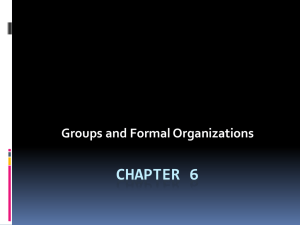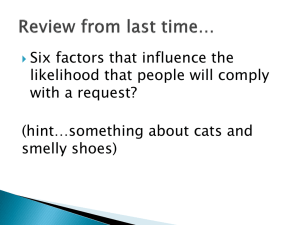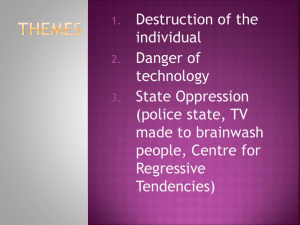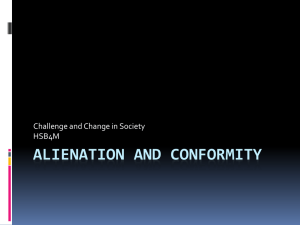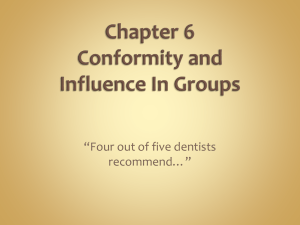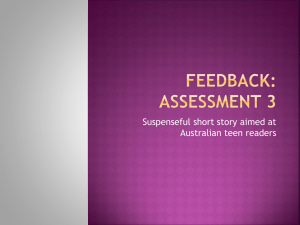The Pedestrian close reading
advertisement
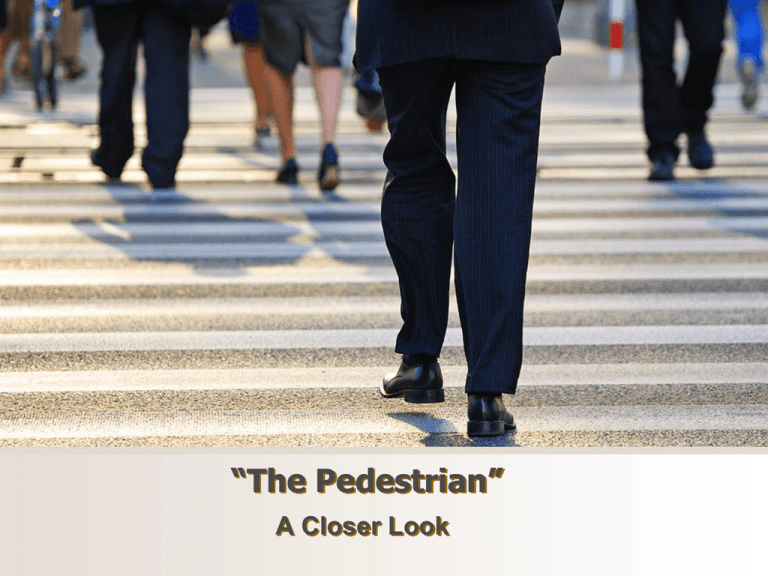
“The Pedestrian” A Closer Look What is a pedestrian? (noun) 1. a person who goes or travels on foot; walker. (adjectives) 2. going or performed on foot; walking. 3. of or pertaining to walking. 4. lacking in vitality, imagination, distinction, etc.; commonplace; prosaic or dull: a pedestrian commencement speech. How does the author incorporate the definitions in story? • a person who goes or travels on foot; walker. • The protagonist, Leonard Mead, is a traveler on foot or walker. enjoys walking neighborhood at night. • going or performed on foot; walking. of or pertaining to walking. – The protagonist, Leonard Mead, enjoys walking neighborhood at night. • lacking in vitality, imagination, distinction, etc.; commonplace; prosaic or dull – The suburban life: Bradbury compares life to a tomb, says they communities are empty. One theme: CONFORMITY 1. action in accord with prevailing social standards, attitudes, practices, etc. 2. correspondence in form, nature, or character; agreement, congruity, or accordance. 3. compliance or acquiescence; obedience. 4. a type of social influence involving a change in belief or behavior in order to fit in with a group. This change is in response to real (involving the physical presence of others) or imagined (involving the pressure of social norms / expectations) group pressure. One theme: CONFORMITY 1. Is there a place for conformity in society? 2. Why? 3. How do you feel when you are expected to conform? 4. Do you encourage conformity or rebel against it? Next:preform a close reading on story • The next few slides will assist you in perform a close reading. How to do a close reading? • http://www.youtube.com/watch?v=adXdTXEzmzE (YouTube clip) • Consider these four elements – – – – Language Narrative Syntax Context Language (diction used to fit the audience, style and purpose of the text) • What did the author repeat? • What was emphasized? • What kind of language is used? – Formal/informal – Slang – Figurative language/mood words • What words are important to understanding the theme/thesis? Narrative (the story) • Who is telling the story? • From what perspective (point of view) is the story told? • How is the story told? • What motivates the narrator to tell the story in this manner? Syntax (the order author’s arrange their words to provide meaning/get a point across) (grammar/sentence structure) • Does the author use Standard American English? • Why would the author use nonstandard syntax? • Who is the audience? • How does this writing style affect the audience? Context (happenings surrounding story’s authorship) • What is the setting of the story? • What is the background of the author? • In what environment was the story written? (what was happening at the time the story was written?) Language • Used informal language(conversational) • Slang (reveals the mindset of the protagonist) Language • What did the author repeat/emphasize? – The idea of suburban lifestyle as a tomb/place for the dead/emptiness(cars like scarab beetles; homes tombs; emptiness of police – Mead’s walk was really just to take a stroll about the community – The idea that Mead had no TV (accusative silence) Language • Imagery – Helps describe the setting • Crystal frost of the air • Sound of leaves crushing under his sneakers • Skeleton pattern of fallen leaf, rusty smell • Cloverleaf intersection – Describe the police/police car • Metallic voice • Sent, feel, and size of the backseat of car Narrative • Who is telling the story/ what point of view? – Unknown omniscient narrator • How is the story told? – Author uses narration at beginning to set the scene/ next allows the reader to experience the story through dialogue – Allows the reader to connect and identify with the protagonist • What motivates the narrator to tell the story in this manner? – Explain the dangers of overusing technology – Explain how pedestrian (see fourth definition) life will become if technology becomes our main focal point. – Persuade readers to unplug sometimes and enjoy life Syntax (grammar/sentence structure) • Syntax should match both audience and subject matter. • Author uses simple and complex sentences. – Simple sentences used to ensure all readers could both enjoy and understand the narrative – Complex sentences used to match the complex subject matter of the dangers of conformity. Context • Setting: 1950’s Cali suburb – 50’s • Cold War • Space race • WWII recovery • Communism v/s capitalism • Korean Conflict Context • Ray Bradbury’s life – Lived with a large extended family – Wrote science fiction – Activist against humanity’s total dependence on science – Friends with Gene Rodenberry (Star Trek) – Married w/ children – Didn’t drive nor owned a car – Enjoyed daily strolls Context • Setting: 1950’s Cali suburb – Story’s setting • 1950 • California • Suburbia – American Dream – Safety – Conformity • Taking a western stroll – West symbolizes » of moving away from wisdom » Death » from nature to technology Context • Setting: 1950’s Cali suburb – Story’s setting (cont.) • Meets at a Clover Leaf intersection – Clovers symbolize luck – Intersections symbolize choices • Taking a western stroll – West symbolizes » of moving away from wisdom » Death » from nature to technology How do these aspects help readers understand the text? • Language/syntax – Simple and some complex to better understand the tone – Purpose of story • To entertain • To persuade against a life controlled by technology How do these aspects help readers understand the text? • Narrative – Heavy dialogue to help the reader connect with the text – Allows the reader to evaluate/juxtapose his/her life to the experiences of the characters How do these aspects help readers understand the text? • Context – Leaves reader with an awareness of society – Allows readers to make a choice about science and technology (friend of foe), how both have affected history and humankind, and if conformity is a danger of society or the protector of society? Works Cited Beers, Kylene, Carol Jago, Deborah Appleman, Leila Christenbury, Sara Kajder. Elements of Literature, Fourth Course. Austin: Holt Rinehart Winston, 2008. (Print).
